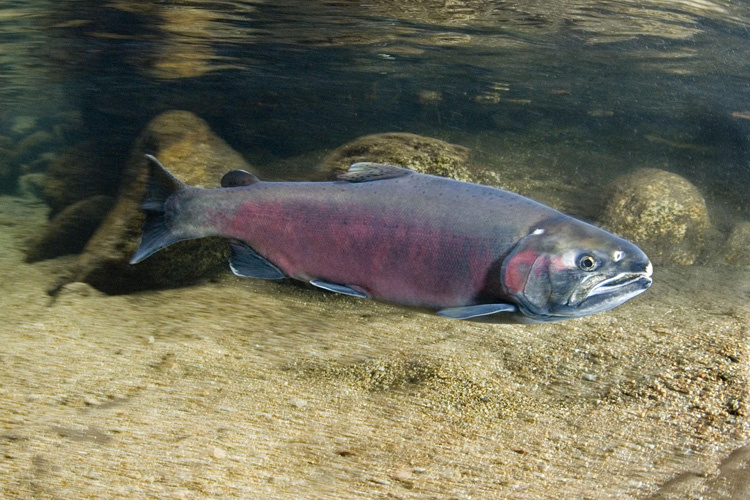Pacific Northwest king (chinook) and silver (coho) salmon runs plagued by drought and warmer ocean waters are new additions to the overfished species list in the federal 2018 Status of U.S. Fisheries released Friday.
In the Atlantic, bigeye tuna joined the overfished list — reflecting the continuing inability of international regulators to rein in other nations’ fleets in the eastern Atlantic. For the first time, Atlantic mackerel between North Carolina and Maine are declared overfished, based on a first comprehensive assessment.
The good news, according to NOAA, is that rebuilding sustainable fisheries is still on its slow upward track since 2000, with 45 stocks now declared rebuilt. The latest is the Gulf of Maine smooth skate, after a 9-year rebuilding effort that included a prohibition on landings.
That success follows the 2016 rebuilding of barndoor skate in New England waters. “The renewed fishing opportunity and market for barndoor skate wings, following its rebuilt status, may lay the market foundation for a smooth skate fishery in the future,” the annual NMFS report noted.
On balance, NOAA officials tout continued slow progress, although they acknowledge climate changes and other environmental factors are more challenging than managing fishermen.
“Let’s say that again: Over 90 percent (of U.S. fish stocks) are not subject to overfishing,” said Alan Risenhoover, director of NOAA’s Office of Sustainable Fisheries, in opening a telephone press conference with reporters Friday.
Of 476 identified stocks in U.S. waters, overfishing status has been calculated for just two-thirds of those, but the knowledge base continues to grow, said Risenhhover.
“The important thing to look at here is things are not static,” he said.
Climate trends figure in the negative changes for salmon. King salmon fall runs in the Klamath and Sacramento rivers are now designated as overfished, while silver salmon in Puget Sound-Snohomish, the Strait of Juan De Fuca, and Queets on the Washington state coast were also added, along with blue king crab around Saint Michael Island in Alaska.
Relatively warmer ocean waters are thought to be taking a toll, while “some of the salmon runs there have been subject to disaster declarations under the Magnuson Act in recent years,” said Risenhoover.
In the Gulf of Mexico, lane snapper and gray snapper are now subjected to overfishing, according to the report. NOAA officials say environmental influences are changing there as well with bigger freshwater flows coming into the gulf, a recent pattern repeated this year with prolonged high water and flooding on the Mississippi River.
As in other years, it’s a mixed bag with good news as well. Stocks where overfishing has ended include Puget Sound-Stillaguamish silver salmon, Puerto Rico spiny lobster, South Atlantic red grouper, and bigeye tuna in the western and central Pacific.
Atlantic bigeye is another problem for U.S. fishermen, who catch less than 1 percent of the annual landings but stand to lose even that because of failure to halt overfishing, particularly in the Gulf of Guinea off western Africa.
“So it’s very hard for us to work on that,” said Risenhoover.
Prized in the markets as “New York bigeye,” the summer and fall fishery supplies the domestic U.S. demand for high-end, sushi-quality fresh fish. But its future is uncertain as the International Convention for the Conservation of Atlantic Tunas has been unable to enforce necessary reductions in the eastern and southern Atlantic fishing.
Reported catches of 79,909 metric tons and 76,982 mt in 2016-17 exceeded the total allowable catch of 65,000 mt, according to a July 2018 report by ICCAT’s bigeye tuna stock assessment committee.
“Comparison of the average annual catches for the period 2010-15 with those for the period 2016-17 show that many fleets have increased average landings and only a few fleets… have reduced such landings, most fleets having increased landings,” the committee reported.
Those are largely juvenile bigeye off Africa, "and these are real juveniles, four to five pounds compared to 100 pounds" that U.S. fishermen catch, said Ray Bogan, a longtime member of the U.S. ICCAT delegation.
They are often caught in the purse seine fishery in association with yellowfin tuna, and there's a long-running argument over whether that makes it a bycatch or directed fishery. Meanwhile, U.S. fishermen "strictly comply with a minimum size and we have significant restrictions on U.S. longliners," said Bogan.
"Should we be sanctioning U.S. fishermen with more severe restrictions when they've already done so much?" Bogan added. "If we shut down to zero, we can't save that bigeye fishery."
Atlantic mackerel fishing has declined over the last couple of decades and is no in line for a rebuilding plan.
"Prior to 2018, the status was unknown so we now have information about the stock and will work with fishery management councils to develop measures to end overfishing and rebuild it to sustainable levels,” according to a statement from NOAA officials.
“This stock is fished by both U.S. and Canadian fishermen, and in some years, non-U.S. catch has been significantly higher than U.S. catch. The (Mid-Atlantic) council is ahead of schedule and a 5-year rebuilding plan is expected to be in place by August 2019.”







